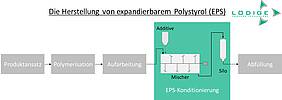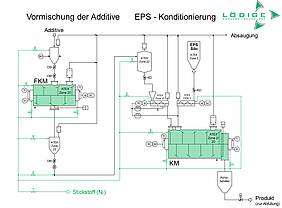Expanded polystyrene, or EPS, is an essential material in industries that range from construction to packaging. Depending on the purpose it is used for, EPS may need special characteristics such as anti-static or flame-retardant properties or a specific colour. This can be achieved by introducing additives, often in very small quantities. Horizontal Ploughshare® Mixers have proved to be ideal for this complex process engineering task.
EPS was invented nearly 70 years ago. In 1952 BASF first presented the material, which is very light in weight but also robust, under the brand name "Styropor" at the plastics fair in Düsseldorf, Germany. Today, EPS is used throughout the world. In 2018, 10.3 million tons of the material were produced.1 According to market studies, an increase of 2.6 percent per year in the global demand for EPS is expected in the period up to 2026.2
Expanded polystyrene – a versatile material
There are good reasons for the high level of demand for EPS. The small beads may consist of 98 percent air, but they are highly functional. The air in EPS keeps the material's thermal conductivity to a minimum, which in turn makes it an ideal insulating material. EPS is also characterised by its light weight, high compressive strength and shock absorbing properties. In addition, this cost-effective material can be processed in a number of ways. It can be pressed into a wide variety of shapes and then simply sawn, milled or cut to size. This makes EPS suitable for a wide variety of applications. In the construction industry, it is used to insulate buildings from cold, heat and noise and helps to increase their energy efficiency. In Europe, 60 percent of the demand for EPS comes from the construction industry. But EPS is also an essential material in the packaging industry. Boxes made of EPS are perfect for transporting temperature- or pressure-sensitive foods. And, thanks to this material, electric appliances, such as computers and fridges, reach customers undamaged. EPS is manufactured using a polymerisation process which involves making styrene monomer in liquid form into polymers. The blowing agent pentane is then added to the polystyrene beads that are produced in this process. The result is EPS granulate which can be turned into foam. The hard-plastic beads, which are filled with pentane, are transformed into foam by applying water vapour at a temperature of around 100°C. During this process, the blowing agent evaporates, and the compact EPS beads expand to up to 50 times their original volume. They can then be manufactured into panels, blocks and also more complex shapes.
Processing in the Ploughshare® Mixer
EPS comes in many different forms. After the polymerisation phase, additives can be used to give it specific properties. Horizontal Ploughshare® Mixers have proved to be ideal for this complex process engineering task. These mixers operate on the basis of the mixing and fluid process developed by Lödige Process Technology, which produces excellent mixing results. The central feature of the mixer is a special arrangement of Ploughshare® Shovels on a horizontal shaft. They rotate in a cylindrical mixing vessel which is positioned horizontally. The size, number, position, shape and circumferential speed of the shovels are carefully coordinated to create a three-dimensional movement in the materials during the mixing process. This means that the materials are continuously mixed by the mixing tools to prevent dead spots or areas of low movement from forming. To achieve the desired product characteristics, EPS beads are coated with additives after fractioning. Additives are applied to EPS for reasons that include:
- Producing special flow characteristics
- Creating flame-retardant properties
- Adding colour
- Producing anti-static properties
Processing the plastic beads presents particular challenges. Only very small quantities (less than one percent) of additives in fine powder or liquid form are introduced. Nevertheless, it is essential to achieve a homogeneous mixture and a consistently high product quality.
Another process engineering problem is the use of pentane as a blowing agent in the production process. Firstly, the gas atmosphere during the design and construction of the system means that the requirements of ATEX directive 2014/34/EU must be met. Secondly, the mixing process, which is intensive but causes no harm to the product, must be performed without any energy input. Even temperatures above 40°C can result in the blowing agent expanding the beads.



